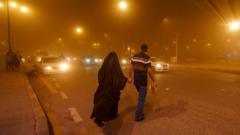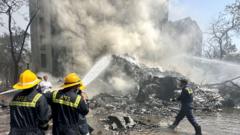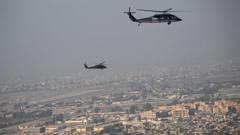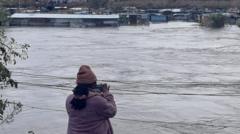As a potent sandstorm sweeps through central and southern Iraq, health officials report a significant rise in respiratory problems, with authorities urging caution amidst worsening weather conditions.
Iraq Battles Health Crisis as Sandstorm Causes Respiratory Issues

Iraq Battles Health Crisis as Sandstorm Causes Respiratory Issues
Severe sandstorm engulfs Iraq, leaving over 1,000 individuals struggling to breathe
A recent sandstorm has wreaked havoc across Iraq, primarily impacting the central and southern regions of the country. The severe weather phenomenon has resulted in more than 1,000 individuals suffering from respiratory issues, according to health officials. Reports from Muthanna province indicate at least 700 cases of suffocation as local emergency services scramble to respond to the health crisis.
Footage circulating online portrays a landscape shrouded in an eerie orange haze, highlighting the extent of the storm’s impact. Alongside health emergencies, residents faced power outages and disruptions in air travel, forcing airports in Najaf and Basra to suspend operations temporarily. Local authorities reported that pedestrians and police donned face masks to mitigate exposure to the hazardous conditions stemming from the dust-laden air.
Health facilities have been overwhelmed. In Najaf province alone, over 250 people required hospitalization, with an additional 322 patients—including minors—admitted in Diwaniyah province. Meanwhile, in Dhi Qar and Basra provinces, around 530 individuals reported experiencing breathing difficulties. Visibility dropped to less than one kilometer, exacerbating the dangers posed by the storm.
Local weather services predict gradual improvements in conditions by Tuesday morning; however, the long-term implications of such weather events remain concerning. Iraq is identified by the UN as one of the five countries most susceptible to climate change, experiencing an increasing frequency of sandstorms, extreme heat, and water scarcity. The country’s environment ministry warns that future projections indicate a rise in the number of "dust days," underscoring the urgent need for effective climate adaptation strategies.
This recent sandstorm is reminiscent of a previous severe event in 2022, which resulted in one death and over 5,000 requiring medical treatment for respiratory challenges. Observers indicate that climate change may be a significant factor in the increased frequency and intensity of these dust storms, prompting a wider conversation about environmental policy and public health preparedness in Iraq and beyond.





















